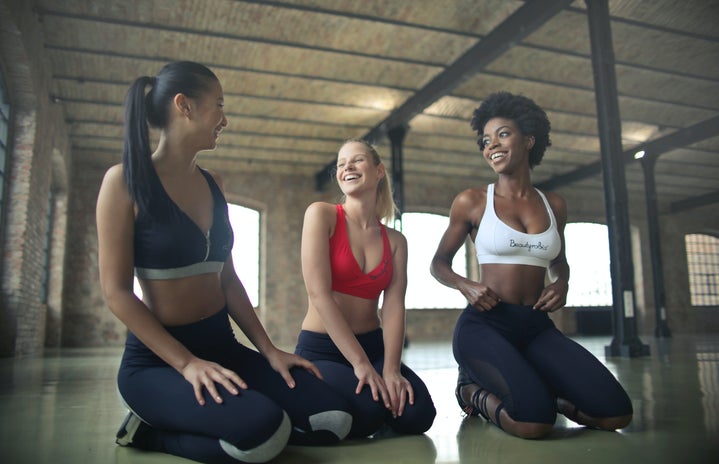I will never forget my first period. It was January of my 6th grade year and, as a self-conscious twelve year old, I wasn’t quite sure what to do when a regular bathroom break unexpectedly turned into my entrance into womanhood. I started shaking when I saw the blood, wishing I had a pad or that I was at home so my mom could help me. Unfortunately, my only option was to wrap up a big wad of toilet paper, put it in my underwear, and hope for the best.
I’ve had my period for almost nine years now and, although I’m no longer fazed by the blood or the fact that I sometimes need to “roll my own”, I still have mixed feelings about periods. On the one hand, I think periods are pretty awesome because they symbolize my ability to have kids and keep the human race alive. However, even though periods symbolize something beautiful, personal care companies have turned this natural bodily process into method of making money. It’s a method that not only hurts our wallets but also degrades our environment and deprives many women in our country of dignity.
Until I came to college, I never really thought about the cost of feminine hygiene products. My mom always kept our bathroom stocked and the money wasn’t coming out of my own wallet. However, now that I’m in college and do my own shopping, I’ve felt the monetary consequences. I did some online research to see the specific prices of the tampons and pads that I buy. I discovered that the pads and tampons I use for each period totals about $5.33. From there I calculated the amount of money that I will have paid by the time I hit menopause, and I was shocked to see such a large number: $2,633. That money could be used for so many other things (like my student loans), and seeing that large number made me realize that had to change.
In addition to ripped off by companies like Tampax, our environment suffers too. I alone use more than 260 disposable tampons every year (which is approximately 1,000 in my lifetime) and unfortunately, all of those tampons (along with their packaging) end up in a landfill, polluting the planet. Not only that, but our bodies become polluted as well. Did you know that tampons contain a carcinogen (cancer-causing substance) called dioxin? If you didn’t know, you’re not alone; companies that produce feminine hygiene products are not required by law to disclose the ingredients used to produce their products, so a lot of women never know about the toxins that they’re putting in their bodies. I do not want pollution, whether in the environment or within my own body, to be a part of my period.
My eyes were opened to another inequality when I started watching Orange Is The New Black; women in prison are not provided with feminine hygiene products. Incarcerated women are expected to purchase tampons and pads from the prison commissary with money they earn while working in prison which, on average, is 12 cents per hour. Using my calculation of $5.33/period, an incarcerated woman would need to work 44 hours just to buy enough feminine hygiene supplies for one period. Most incarcerated women are unable to meet this unrealistic expense so they are forced to either bleed freely or create makeshift supplies using toilet paper, bedding, etc. Not only are those things unsanitary, but it also very degrading. A non-profit organization called A Woman’s Worth works to promote worth and dignity for women around the globe. In a letter to this non-profit, an incarcerated woman wrote, “[menstruation in prison] is an experience that either intentionally works to degrade inmates, or degrades us as a result of cost-saving measures: either way, the results are the same. Prison makes us hate part of ourselves; it turns us against our own bodies. ” The health and dignity of those who are incarcerated (and any women who cannot afford feminine hygiene products) is compromised when adequate menstrual products are not available. This was the tipping point for me; how could I continue relying on tampons and pads for my menstrual care when they were doing so much harm?
Ironically, right around the peak of my frustration, Her Campus National sent a free DivaCup to our chapter. For those who don’t know, a DivaCup (or menstrual cup) is a menstrual care product that is more sustainable and cost effective than tampons or pads because it is reusable. The product is made of silicon, is inserted like a tampon, and keeps blood inside of your body with its cup-like structure. When I first heard about the DivaCup a year earlier I was really grossed out by the concept; it didn’t sound sanitary or comfortable, so I completely disregarded the idea. However, it sounded like a product that addressed the complaints I had with tampons so, when Her Campus Gustavus received one in the mail, I volunteered to try it out.
My first experience using a DivaCup was absolutely incredible. For the first time in my entire life, I didn’t feel disrupted by my period. Not only was I able to go through an entire day of classes without needing to worry about changing the product because of its 12 hour leak protection, but I could also go to sleep at night without worrying that I would ruin my favorite underwear (R.I.P. pink thong) or wake up with blood stains on my sheets. I was able to run, dance, sleep, and go to the bathroom as if it was any other day of my life, and I’ve never felt so liberated.
In addition to feeling liberated, I also felt like a better citizen. Although it costs $30 to purchase a DivaCup, that investment (which lasts for year or more, depending on maintenance) ends saving me around $2,000 in period payments over the course of my life (think about all the ways you could use that extra $2,000!). Also, since the product is reusable, the amount of waste I produce decreases drastically by using a DivaCup (not to mention that, unlike tampons, DivaCups do not contain carcinogens). Even though it isn’t a direct solution for incarcerated women, it’s a step in the right direction for people trying to require prisons to provide menstrual care because of its sustainability and cost effectiveness.
Now that I’ve used a DivaCup, I’m never going back. My choice to continue using a menstrual cups stems from wanting to feel less disturbed by my period and from my passion for social justice. A lot of people (just like me, one year ago) have a lot of prejudice against menstrual cups because they are unfamiliar with and uneducated about the product. Maybe that’s you. However, I challenge you to remember that just because something is different doesn’t mean it’s weird. If we can get past the stigma and start normalizing the DivaCup, we have the potential to change the world.
HCXO!

